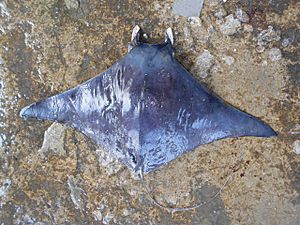Shortfin devil ray facts for kids
Quick facts for kids Shortfin devil ray |
|
|---|---|
 |
|
| Conservation status | |
| Scientific classification | |
| Kingdom: | |
| Phylum: | |
| Class: | |
| Order: | |
| Family: |
Mobulidae
|
| Genus: |
Mobula
|
| Species: |
M. kuhlii
|
| Binomial name | |
| Mobula kuhlii (J.P. Müller & Henle, 1841)
|
|
| Synonyms | |
|
|
The shortfin devil ray (Mobula kuhlii) is a type of ray. It belongs to the Mobulidae family. You can find this ray in the Indian Ocean and the central-west Pacific Ocean. Its home ranges from South Africa to Australia. This includes countries like Mozambique, Tanzania, the Seychelles, the Philippines, and Indonesia.
What Does the Shortfin Devil Ray Look Like?
The shortfin devil ray is a smaller type of eagle ray. It can grow up to 120 cm (47 in) wide. Its weight can reach about 30 kilograms (66 lb). Its body is flat and wide. It has a short head with small fins on the sides. These are called cephalic fins. Its large side fins (pectoral fins) have curved tips. The fin on its back has a white tip. The ray's tail is shorter than its body. It does not have a sharp spine. The top of the ray is brown. It does not have scales like many fish. The underside of its body is white.
Shortfin Devil Ray Life Cycle and Diet
The shortfin devil ray eats tiny living things called plankton. It might also eat small fish and squid. It catches food by swimming with its mouth open. Water flows over special filters in its gills. These filters, called gill rakers, trap the food particles.
This ray gives birth to live young. The eggs hatch inside the mother's body. Shortfin devil rays have a very slow rate of reproduction. They usually have only one baby at a time. The mother carries the baby for one to three years before it is born.
Why the Shortfin Devil Ray Needs Our Help
The International Union for the Conservation of Nature says this ray is endangered. This means it is at a high risk of disappearing forever. People catch shortfin devil rays on purpose. They also catch them by accident while fishing for other things. Because these rays have so few babies, they are easily overfished.
People catch these rays in places like India, Sri Lanka, and Thailand. In Indonesia, they are often caught for their gill rakers. These gill rakers are used in some traditional medicines. The ray's meat is eaten by people. Its skin can be dried and fried. Even its cartilage is used as a filler in some foods, like shark fin soup.


